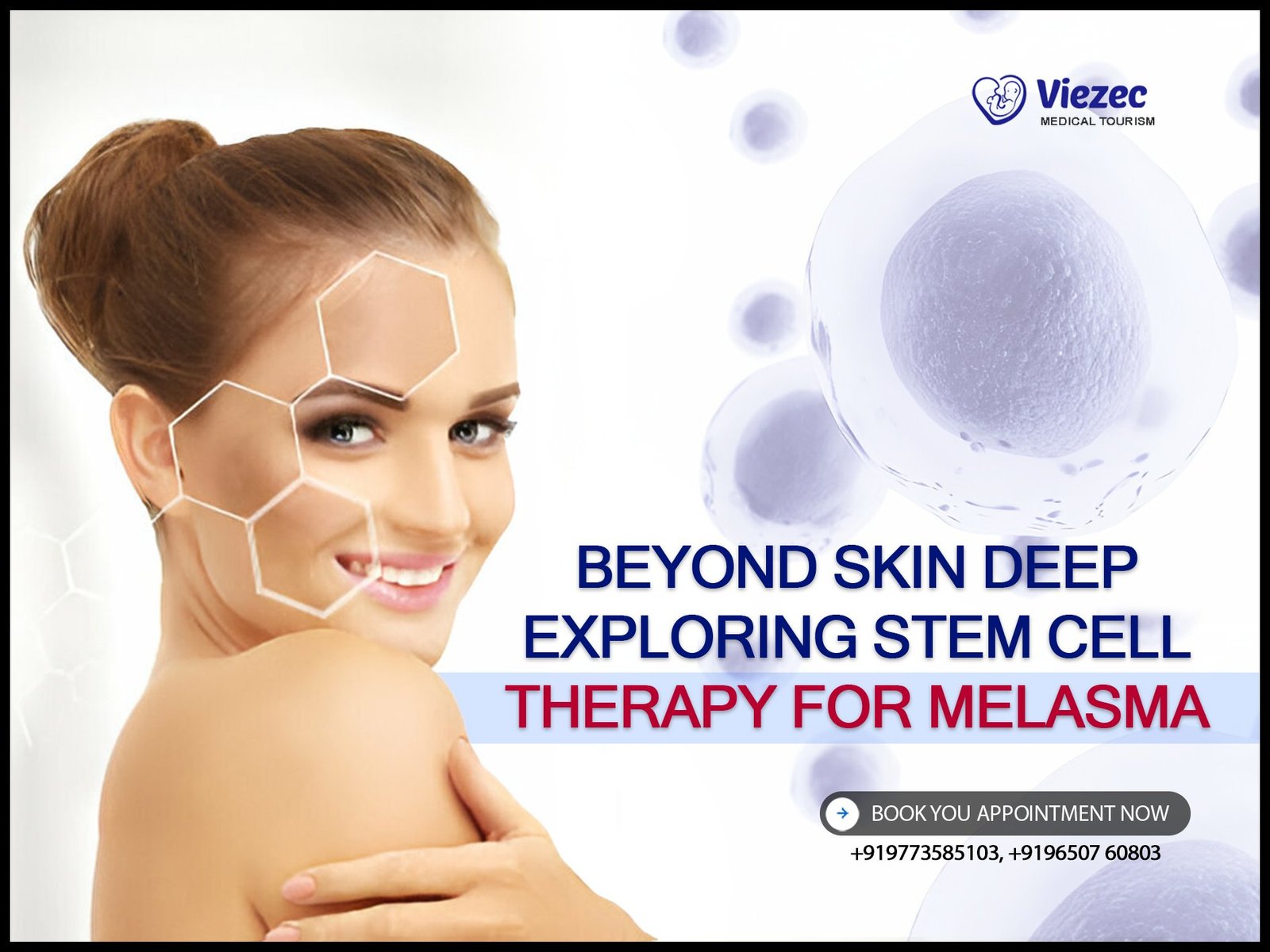Melasma, a common skin condition characterized by symmetrical, hyperpigmented patches typically on the face, poses significant challenges in management and treatment due to its complex etiology and variable clinical presentation.
Understanding Melasma: Causes and Symptoms
Melasma arises from a combination of genetic predisposition, hormonal influences, ultraviolet (UV) radiation exposure, and other external factors. The hallmark symptomatology includes irregular brown to gray-brown patches on sun-exposed areas, primarily the face.
Current Treatment Landscape for Melasma
Conventional therapies for melasma primarily focus on topical agents, such as hydroquinone, corticosteroids, and retinoids, often supplemented with chemical peels and laser treatments. However, these approaches frequently yield suboptimal results and may be associated with adverse effects, highlighting the need for novel interventions.
Stem Cell Therapy Fundamentals
Stem cell therapy offers a promising avenue in dermatology by harnessing the regenerative potential of stem cells to address various skin disorders, including melasma.
A. Basics of Stem Cells: Types and Characteristics
Stem cells, characterized by their capacity for self-renewal and differentiation into specialized cell types, exist in various forms, including embryonic stem cells (ESCs), mesenchymal stem cells (MSCs), and induced pluripotent stem cells (iPSCs). Each type harbors distinct properties and therapeutic potentials.
B. Mechanisms of Stem Cell Therapy in Skin Disorders
Stem cell therapy operates through multifaceted mechanisms, encompassing modulation of inflammation, promotion of tissue repair, and regulation of melanogenesis pathways. These mechanisms underpin the potential efficacy of stem cells in mitigating melasma-related hyperpigmentation.
Melasma Pathophysiology: Insights and Implications
Understanding the intricate interplay of cellular and molecular processes underlying melasma pathogenesis is essential for devising targeted therapeutic strategies.
Cellular and Molecular Basis of Melasma Development
Melasma pathophysiology involves dysregulation of melanocytes, keratinocytes, and dermal microenvironment components, influenced by hormonal fluctuations, genetic factors, and environmental triggers. Elucidating these mechanisms unveils novel molecular targets for intervention.
Role of Stem Cells in Regulating Melanogenesis
Stem cells exert modulatory effects on melanogenesis by secreting paracrine factors, promoting melanocyte migration and differentiation, and modulating melanin synthesis pathways. Harnessing these regulatory functions holds promise for controlling aberrant pigmentation in melasma.
Emerging Trends in Melasma Management
Despite advancements in conventional therapies, their limitations underscore the urgent need for innovative approaches, including stem cell-based interventions.
Limitations of Conventional Therapies for Melasma
Conventional treatments often yield temporary outcomes and may induce adverse reactions, necessitating prolonged maintenance therapy and compromising patient adherence. Additionally, refractory cases pose a clinical challenge, necessitating alternative modalities.
Promise of Stem Cell-Based Interventions
Stem cell-based therapies offer a paradigm shift in melasma management by addressing underlying pathogenic mechanisms, fostering tissue regeneration, and providing sustained therapeutic effects with potentially lower adverse event profiles.
Types of Stem Cells in Melasma Treatment
Various types of stem cells demonstrate distinct properties and applications in the context of melasma treatment, each offering unique advantages and challenges.
Mesenchymal Stem Cells (MSCs) and Their Applications
MSCs, sourced from various tissues like adipose tissue and bone marrow, exhibit immunomodulatory and regenerative properties, making them attractive candidates for melasma therapy. Their ease of isolation and expansion further augments their therapeutic potential.
Induced Pluripotent Stem Cells (iPSCs) in Melasma Therapy
iPSCs, reprogrammed from somatic cells, possess pluripotency and can differentiate into diverse cell lineages, including melanocytes. Their patient-specific derivation and customizable properties offer tailored therapeutic approaches for melasma.
Preclinical Studies on Stem Cell Therapy for Melasma
Preclinical investigations using animal models provide valuable insights into the safety, efficacy, and mechanisms of action underlying stem cell-based interventions for melasma.
Animal Models for Melasma: Insights and Challenges
Animal models, including murine and porcine models, recapitulate key aspects of melasma pathophysiology, facilitating preclinical efficacy assessments and mechanistic studies. However, species-specific differences and limitations in replicating human disease phenotypes warrant cautious interpretation.
Efficacy and Safety Assessment of Stem Cell Treatments
Preclinical studies elucidate the therapeutic potential of stem cell-based therapies in ameliorating melasma-associated hyperpigmentation, demonstrating favorable outcomes in terms of efficacy and safety profiles. These findings lay the groundwork for translational research into clinical settings.
Clinical Trials and Case Studies
Translating promising preclinical results into clinical practice necessitates rigorous evaluation through well-designed clinical trials and real-world case studies.
Investigational Stem Cell Therapies: Clinical Trial Findings
Clinical trials investigating stem cell-based interventions for melasma demonstrate encouraging outcomes in terms of pigmentation improvement, skin texture enhancement, and patient satisfaction. Long-term follow-up studies are essential to assess durability and safety.
Real-World Applications: Case Studies and Patient Outcomes
Real-world case studies corroborate the efficacy and safety of stem cell therapies in diverse patient populations, highlighting their potential as viable treatment options for refractory melasma cases. Comprehensive outcome assessments encompassing patient-reported measures are crucial for evaluating treatment efficacy holistically.
Challenges and Considerations in Stem Cell Therapy
Despite the promising prospects of stem cell therapy, several challenges and considerations warrant careful deliberation for successful clinical implementation.
Regulatory Framework and Ethical Concerns
Navigating regulatory pathways and ethical considerations surrounding stem cell research and therapy necessitates adherence to established guidelines, ensuring patient safety, informed consent, and transparent communication.
Addressing Safety, Efficacy, and Long-Term Effects
Comprehensive evaluation of stem cell therapy encompassing safety, efficacy, and long-term outcomes is imperative for establishing evidence-based practice guidelines and mitigating potential risks associated with unanticipated adverse events or tumorigenicity.
Optimizing Stem Cell-Based Approaches
Optimal delivery systems and combinatorial strategies hold promise in enhancing the therapeutic efficacy and clinical outcomes of stem cell-based interventions for melasma.
A. Enhanced Delivery Systems for Stem Cell Therapy
Innovative delivery platforms, including scaffolds, hydrogels, and microneedle arrays, facilitate targeted and sustained release of stem cells and bioactive factors, optimizing tissue integration and therapeutic efficacy.
B. Combinatorial Strategies and Adjunct Therapies
Combining stem cell therapy with complementary modalities, such as growth factors, cytokines, and phototherapy, synergistically augments therapeutic outcomes by targeting multiple pathways implicated in melasma pathogenesis and regeneration.
Future Directions and Innovations
Continued advancements in stem cell research hold promise for unlocking novel therapeutic modalities and personalized approaches in melasma management.
Advances in Stem Cell Research: Implications for Melasma
Ongoing research endeavors focusing on stem cell biology, tissue engineering, and regenerative medicine offer exciting prospects for developing next-generation therapies tailored to individual patient needs, including precision medicine approaches.
Personalized Medicine Approaches in Melasma Management
Integration of patient-specific factors, including genetic predisposition, hormonal status, and environmental influences, into treatment algorithms facilitates personalized medicine strategies, optimizing therapeutic outcomes and patient satisfaction.
Patient Perspectives and Expectations
Understanding patient preferences, concerns, and experiences is integral to delivering patient-centered care and fostering shared decision-making in melasma management.
Understanding Patient Preferences and Concerns
Engaging patients in open dialogue regarding treatment goals, expectations, and apprehensions empowers informed decision-making and enhances treatment adherence and satisfaction. Tailoring treatment plans to accommodate individual needs and lifestyle factors fosters a collaborative therapeutic alliance.
Bridging the Gap Between Science and Patient Experience
Efforts to bridge the translational gap between scientific advancements and patient experiences necessitate comprehensive patient education, support networks, and advocacy initiatives. Empowering patients through accessible information and resources facilitates active participation in their care journey.
Economic and Societal Impacts
Assessing the economic implications and societal considerations surrounding stem cell therapy for melasma informs healthcare resource allocation and equitable access to innovative treatments.
Cost-Effectiveness of Stem Cell Therapy for Melasma
Economic evaluations elucidate the cost-effectiveness and long-term value proposition of stem cell-based interventions compared to conventional therapies, guiding healthcare decision-makers in resource allocation and reimbursement policies.
Socioeconomic Considerations and Access to Innovative Treatments
Addressing socioeconomic disparities in access to innovative treatments necessitates equitable distribution of healthcare resources, affordability initiatives, and patient assistance programs, ensuring inclusivity and accessibility for all individuals regardless of socioeconomic status.
Global Perspectives and Collaborative Efforts
International collaboration and cross-disciplinary partnerships drive innovation and knowledge exchange, fostering a synergistic approach to addressing global healthcare challenges.
International Initiatives in Stem Cell Research and Melasma
Collaborative research consortia and multinational initiatives facilitate data sharing, harmonization of research standards, and capacity building in stem cell research, accelerating the translation of scientific discoveries into clinical applications for melasma and other dermatological conditions.
Cross-Disciplinary Collaboration for Advancing Treatment Paradigms
Interdisciplinary collaboration among dermatologists, stem cell biologists, bioengineers, and healthcare policymakers promotes cross-fertilization of ideas, interdisciplinary research integration, and holistic approaches to melasma management, paving the way for transformative therapeutic innovations.
Educational Outreach and Public Awareness
Disseminating knowledge and fostering public awareness through educational campaigns and patient support networks facilitate informed decision-making and empowerment in melasma management.
Dissemination of Knowledge: Educational Campaigns
Educational initiatives targeting healthcare professionals, patients, and the general public raise awareness about melasma, its underlying pathophysiology, and emerging treatment modalities, fostering a culture of evidence-based practice and proactive skin health management.
Empowering Patients Through Information and Support Networks
Patient support networks, online forums, and advocacy groups serve as invaluable resources for individuals affected by melasma, offering peer support, educational resources, and practical guidance in navigating treatment options and coping strategies, ultimately enhancing patient empowerment and well-being.
Stem cell therapy represents a transformative frontier in melasma management, offering personalized, regenerative solutions that transcend conventional approaches. By leveraging advances in stem cell research, interdisciplinary collaboration, and patient-centered care, we can redefine the paradigm of melasma treatment and empower individuals to embrace skin health beyond surface appearances, delving deeper into the realm of cellular regeneration and holistic well-being.









